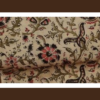Indian ethnic dupattas are a versatile and stylish accessory that can elevate any outfit. They are essentially long pieces of cloth that are draped over the head, shoulders and upper body and typically worn with traditional Indian outfits such as salwar kameez and lehenga choli. Dupattas come in a variety of fabrics, prints, and embellishments and are an integral part of Indian fashion.
History and Evolution of Dupattas:
The origin of dupattas can be traced back to ancient India – where women used to cover their heads as a sign of modesty and respect. Over time, this practice evolved into the use of dupattas – which not only covered the head but also provided warmth and protection from the sun. Dupattas were traditionally made from cotton or silk and were plain or embellished with embroidery, prints, or borders.
As Indian fashion evolved, so did the dupatta. In the 18th and 19th centuries, dupattas became more elaborate and ornate, with the introduction of zari work, gota-patti, and other intricate embellishments. Dupattas also started to be draped in different styles, depending on the region and the occasion. For example, in North India, the dupatta was draped over the head and left to trail behind, while in South India, it was worn across the chest like a shawl.
Today, dupattas are an essential part of Indian fashion, and are worn by women of all ages and ethnicities. They are available in a wide range of fabrics, from cotton and silk to chiffon and georgette, and can be adorned with everything from mirror work to sequins to tassels.
Types of Dupattas:
There are many types of dupattas, each with its own unique style and purpose. Here are some of the most popular types:
- Cotton Dupattas: Cotton dupattas are a popular choice for casual wear as they are lightweight, breathable, and comfortable to wear. They are usually available in a range of prints, such as floral, paisley and geometric patterns, and can be paired with a variety of outfits – such as cotton salwar kameez or kurtis.
- Silk Dupattas: Silk dupattas are a luxurious and elegant choice for formal occasions, such as weddings and parties. They are available in a range of colors, from bright and bold to subtle and muted, and can be embellished with embroidery, zari work or sequins for added glamour.
- Chiffon Dupattas: Chiffon dupattas are a popular choice for summer weddings and parties – as they are lightweight, flowy, and comfortable to wear in hot and humid weather. They are available in a range of pastel shades and can be paired with a variety of outfits, such as chiffon sarees or anarkali suits.
- Phulkari Dupatta: Originating from Punjab, this type of dupatta is embroidered with colorful floral patterns. Phulkari literally means “flower work,” and refers to the intricate embroidery technique used to create these beautiful dupattas. The embroidery is usually done by hand, using brightly colored threads to create a range of geometric and floral patterns.
- Bandhani Dupatta: Bandhani dupattas are a specialty of the western Indian state of Gujarat, and are characterized by their tie-dye patterns. They are usually available in bright and bold colors, and can be paired with a variety of outfits, such as lehenga choli or salwar kameez.
- Banarasi Dupatta: Banarasi dupattas are a specialty of the northern Indian city of Varanasi, and are known for their intricate gold and silver zari work. They are usually available in rich and vibrant colors, such as maroon, red, and green, and can be paired with a variety of outfits, such as banarsi sarees or Anarkali suits.
- Chikankari Dupatta: Originating from Lucknow, this type of dupatta is embroidered with delicate white thread work on a lightweight fabric such as cotton or georgette. The embroidery on chikankari dupattas is typically done by hand, using a variety of stitches, such as satin stitch, chain stitch, and buttonhole stitch. The designs may feature floral motifs, paisley patterns, or other intricate geometric shapes.
How to Style Dupattas:
Dupattas can be styled in a variety of ways, depending on the occasion and the outfit. Here are some ideas:
- Drape it over the head and let it trail behind for a traditional look.
- Drape it across the chest like a shawl for a more modern look.
- Use it as a belt to cinch in the waist and add definition to a loose outfit.
- Wrap it around the neck like a scarf for a cozy and stylish look.
Final Thoughts:
Indian ethnic dupattas are a beautiful and versatile accessory that can add a touch of elegance and tradition to any outfit. Whether you are attending a wedding, a festival, or just going out with friends, a dupatta can take your look to the next level. With so many styles, fabrics, and embellishments to choose from, there’s a dupatta for every occasion.



